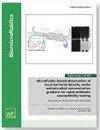用于快速功能筛选和从细菌菌株库中分离病原体抑制剂的光可寻址微孔装置
IF 2.4
4区 工程技术
Q2 BIOCHEMICAL RESEARCH METHODS
引用次数: 0
摘要
发现能抑制病原体生长的新菌株有助于改进生物控制和益生菌策略。探究微生物相互作用的传统平板共培养方法可能会阻碍这种发现,因为这些方法本身具有低通量、劳动密集和定性的特点。我们报告了一种第二代光敏可寻址微孔装置,该装置用于迭代筛选细菌菌株库中的候选生物控制剂与病原体之间在病原体压力不断增加的情况下的相互作用。微孔(体积为 0.6 pl)以可控的细胞比例为菌株库菌株和病原体提供了独特的共培养场所。在连续的迭代筛选过程中,库菌株会受到越来越多病原体的挑战,从而定量识别出含有抑制病原体数量最多的菌株的微孔。然后用波长为 365 纳米的环形光消融光降解水凝胶膜,并依次从装置中释放出抑制性菌株进行回收。对每个回收菌株的病原体抑制作用进行验证,然后进行全基因组测序。为了证明这种方法的快速性,我们利用该装置筛选了一个 293 元生物菌株 1 农杆菌菌株库,以寻找对植物病原体农杆菌 15955 有抑制作用的菌株。一次反复筛选发现了九种新的抑制菌株。相比之下,基于平板的方法没有从菌株库中发现任何抑制性菌株(n = 30 个平板)。本文开发的新型病原体挑战筛选模式能从细菌菌株库中快速筛选和回收能有效抑制病原体生长的菌株,从而将微孔技术平台扩展为快速、经济、可扩展的益生菌、生物控制剂和抑制分子筛选平台,这些分子能抵御已知或新出现的病原体。本文章由计算机程序翻译,如有差异,请以英文原文为准。
Photo-addressable microwell devices for rapid functional screening and isolation of pathogen inhibitors from bacterial strain libraries
Discovery of new strains of bacteria that inhibit pathogen growth can facilitate improvements in biocontrol and probiotic strategies. Traditional, plate-based co-culture approaches that probe microbial interactions can impede this discovery as these methods are inherently low-throughput, labor-intensive, and qualitative. We report a second-generation, photo-addressable microwell device, developed to iteratively screen interactions between candidate biocontrol agents existing in bacterial strain libraries and pathogens under increasing pathogen pressure. Microwells (0.6 pl volume) provide unique co-culture sites between library strains and pathogens at controlled cellular ratios. During sequential screening iterations, library strains are challenged against increasing numbers of pathogens to quantitatively identify microwells containing strains inhibiting the highest numbers of pathogens. Ring-patterned 365 nm light is then used to ablate a photodegradable hydrogel membrane and sequentially release inhibitory strains from the device for recovery. Pathogen inhibition with each recovered strain is validated, followed by whole genome sequencing. To demonstrate the rapid nature of this approach, the device was used to screen a 293-membered biovar 1 agrobacterial strain library for strains inhibitory to the plant pathogen Agrobacterium tumefaciens sp. 15955. One iterative screen revealed nine new inhibitory strains. For comparison, plate-based methods did not uncover any inhibitory strains from the library (n = 30 plates). The novel pathogen-challenge screening mode developed here enables rapid selection and recovery of strains that effectively suppress pathogen growth from bacterial strain libraries, expanding this microwell technology platform toward rapid, cost-effective, and scalable screening for probiotics, biocontrol agents, and inhibitory molecules that can protect against known or emerging pathogens.
求助全文
通过发布文献求助,成功后即可免费获取论文全文。
去求助
来源期刊

Biomicrofluidics
生物-纳米科技
CiteScore
5.80
自引率
3.10%
发文量
68
审稿时长
1.3 months
期刊介绍:
Biomicrofluidics (BMF) is an online-only journal published by AIP Publishing to rapidly disseminate research in fundamental physicochemical mechanisms associated with microfluidic and nanofluidic phenomena. BMF also publishes research in unique microfluidic and nanofluidic techniques for diagnostic, medical, biological, pharmaceutical, environmental, and chemical applications.
BMF offers quick publication, multimedia capability, and worldwide circulation among academic, national, and industrial laboratories. With a primary focus on high-quality original research articles, BMF also organizes special sections that help explain and define specific challenges unique to the interdisciplinary field of biomicrofluidics.
Microfluidic and nanofluidic actuation (electrokinetics, acoustofluidics, optofluidics, capillary)
Liquid Biopsy (microRNA profiling, circulating tumor cell isolation, exosome isolation, circulating tumor DNA quantification)
Cell sorting, manipulation, and transfection (di/electrophoresis, magnetic beads, optical traps, electroporation)
Molecular Separation and Concentration (isotachophoresis, concentration polarization, di/electrophoresis, magnetic beads, nanoparticles)
Cell culture and analysis(single cell assays, stimuli response, stem cell transfection)
Genomic and proteomic analysis (rapid gene sequencing, DNA/protein/carbohydrate arrays)
Biosensors (immuno-assay, nucleic acid fluorescent assay, colorimetric assay, enzyme amplification, plasmonic and Raman nano-reporter, molecular beacon, FRET, aptamer, nanopore, optical fibers)
Biophysical transport and characterization (DNA, single protein, ion channel and membrane dynamics, cell motility and communication mechanisms, electrophysiology, patch clamping). Etc...
 求助内容:
求助内容: 应助结果提醒方式:
应助结果提醒方式:


